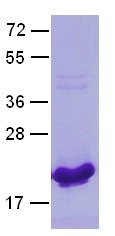Rab5(Q79L) Protein
| 货号: 10117 |
| 产品名称: Rab5 Protein Q79L mutant |
| 基因符号: Member RAS oncogene family, RAB5A |
| Source: Human, recombinant full length, His6-tag |
| Expression 种属反应性: E. coli |
| Molecular Weight: 17 kDa |
| 纯化:: >96% by SDS-PAGE |
| Introduction: Rab5, consists of three isoforms, Rab5A, Rab5B, and Rab5C, is a small GTPase that is localized to early endosomes. It regulates the fusion between endocytic vesicles and early endosomes, as well as the homotypic fusion between early endosomes. |
| Amino Acid Sequence (16-184, Q79L) |
NKICQFKLVLLGESAVGKSSLVLRFVKGQFHEFQESTIGAAFLTQTVCLDDTTVKFEIWDTAGLERY
HSLAPMYYRGAQAAIVVYDITNEESFARAKNWVKELQRQASPNIVIALSGNKADLANKRAVDFQEAQ
SYADDNSLLFMETSAKTSMNVNEIFMAIAKKLPKN |
Properties
|
| Physical Appearance (form): Dissolved in 20mM Tris-HCl, pH8.0, 150mM NaCl. |
| Physical Appearance (form): White or clear |
| 浓度: 1 mg/mL |
| Storage: -80°C |
Preparation Instructions:
Centrifuge the vial before open the cap and reconstitute in water. Adding of 10 mM β-mercaptoethanol or 1 mM DTT into the solution to protect the protein is recommended and using of non-ionic detergents such as n-Dodecyl β-D-maltoside (DoDM) or polyethylene detergents (e.g. C12E10) also help to stabilize the protein. Avoid repeated freezing and thawing after reconstitution. The purity of His-tagged Rab5 Q79L was determined by SDS-PAGE and Coomassie Brilliant Blue Staining. |

References:
1. Bucci, C. et al., Cell 70: 715-728, 1992.
2. Kinchen, J. M. et al., Nature 464: 778-782, 2010.
3. Kitano, M. et al., Nature 453: 241-245, 2008.
4. Lanzetti, L. et al., Nature 429: 309-314, 2004.
5. Lanzetti, L. et al., Nature 408: 374-377, 2000.
6. Miaczynska, M. et al., Cell 116: 445-456, 2004.
7. Ohya, T. et al., Nature 459: 1091-1097, 2009.
8. Otomo, A. et al., Hum. Molec. Genet. 12: 1671-1687, 2003.
9. Rousseau-Merck, M. F. et al., Hum. Genet. 86: 350-354, 1991.
10. Stenmark, H. et al., Cell 83: 423-432, 1995.
11. Xiao, G.-H. et al., J. Biol. Chem. 272: 6097-6100, 1997.
12. Zahraoui, A. et al., J. Biol. Chem. 264: 12394-12401, 1989.











